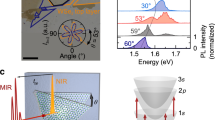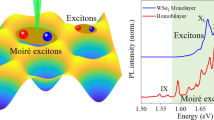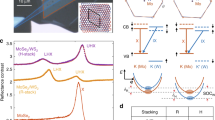Abstract
The nanoscale periodic potentials introduced by moiré patterns in semiconducting van der Waals heterostructures have emerged as a platform for designing exciton superlattices. However, our understanding of the motion of excitons in moiré potentials is still limited. Here we investigated interlayer exciton dynamics and transport in WS2–WSe2 heterobilayers in time, space and momentum domains using transient absorption microscopy combined with first-principles calculations. We found that the exciton motion is modulated by twist-angle-dependent moiré potentials around 100 meV and deviates from normal diffusion due to the interplay between the moiré potentials and strong exciton–exciton interactions. Our experimental results verified the theoretical prediction of energetically favourable K–Q interlayer excitons and showed exciton-population dynamics that are controlled by the twist-angle-dependent energy difference between the K–Q and K–K excitons. These results form a basis to investigate exciton and spin transport in van der Waals heterostructures, with implications for the design of quantum communication devices.
This is a preview of subscription content, access via your institution
Access options
Access Nature and 54 other Nature Portfolio journals
Get Nature+, our best-value online-access subscription
$29.99 / 30 days
cancel any time
Subscribe to this journal
Receive 12 print issues and online access
$259.00 per year
only $21.58 per issue
Buy this article
- Purchase on Springer Link
- Instant access to full article PDF
Prices may be subject to local taxes which are calculated during checkout




Similar content being viewed by others
Code availability
The codes used for exciton diffusion simulation are available from the corresponding author upon reasonable request.
References
Geim, A. K. & Grigorieva, I. V. Van der Waals heterostructures. Nature 499, 419–425 (2013).
Novoselov, K. S., Mishchenko, A., Carvalho, A. & Castro Neto, A. H. 2D materials and van der Waals heterostructures. Science 353, aac9439 (2016).
Rivera, P. et al. Valley-polarized exciton dynamics in a 2D semiconductor heterostructure. Science 351, 688–691 (2016).
Jin, C. et al. Imaging of pure spin-valley diffusion current in WS2/WSe2 heterostructures. Science 360, 893–896 (2018).
Liu, Y. et al. Van der Waals heterostructures and devices. Nat. Rev. Mater. 1, 16042 (2016).
Rivera, P. et al. Observation of long-lived interlayer excitons in monolayer MoSe2–WSe2 heterostructures. Nat. Commun. 6, 6242 (2015).
Xu, W. et al. Correlated fluorescence blinking in two-dimensional semiconductor heterostructures. Nature 541, 62–67 (2017).
Nagler, P. et al. Interlayer exciton dynamics in a dichalcogenide monolayer heterostructure. 2D Mater. 4, 025112 (2017).
Kunstmann, J. et al. Momentum-space indirect interlayer excitons in transition-metal dichalcogenide van der Waals heterostructures. Nat. Phys. 14, 801–805 (2018).
Yu, H., Liu, G.-B., Tang, J., Xu, X. & Yao, W. Moiré excitons: from programmable quantum emitter arrays to spin–orbit-coupled artificial lattices. Sci. Adv. 3, e1701696 (2017).
Chien, C. C., Peotta, S. & Di Ventra, M. Quantum transport in ultracold atoms. Nat. Phys. 11, 998–1004 (2015).
Zhang, C. et al. Interlayer couplings, moiré patterns, and 2D electronic superlattices in MoS2/WSe2 hetero-bilayers. Sci. Adv. 3, e1601459 (2017).
Yu, H., Liu, G.-B. & Yao, W. Brightened spin-triplet interlayer excitons and optical selection rules in van der Waals heterobilayers. 2D Mater. 5, 035021 (2018).
Tran, K. et al. Evidence for moiré excitons in van der Waals heterostructures. Nature 567, 71–75 (2019).
Seyler, K. L. et al. Signatures of moiré-trapped valley excitons in MoSe2/WSe2 heterobilayers. Nature 567, 66–70 (2019).
Jin, C. et al. Observation of moiré excitons in WSe2/WS2 heterostructure superlattices. Nature 567, 76–80 (2019).
Alexeev, E. M. et al. Resonantly hybridized excitons in moiré superlattices in van der Waals heterostructures. Nature 567, 81–86 (2019).
Zhang, N. et al. Moiré intralayer excitons in a MoSe2/MoS2 heterostructure. Nano Lett. 18, 7651–7657 (2018).
Ciarrocchi, A. et al. Polarization switching and electrical control of interlayer excitons in two-dimensional van der Waals heterostructures. Nat. Photon. 13, 131–136 (2019).
Unuchek, D. et al. Room-temperature electrical control of exciton flux in a van der Waals heterostructure. Nature 560, 340–344 (2018).
Jauregui, L. A. et al. Electrical control of interlayer exciton dynamics in atomically thin heterostructures. Science 366, 870–875 (2019).
Snoke, D., Denev, S., Liu, Y., Pfeiffer, L. & West, K. Long-range transport in excitonic dark states in coupled quantum wells. Nature 418, 754–757 (2002).
High, A. A., Novitskaya, E. E., Butov, L. V., Hanson, M. & Gossard, A. C. Control of exciton fluxes in an excitonic integrated circuit. Science 321, 229–231 (2008).
Vögele, X. P., Schuh, D., Wegscheider, W., Kotthaus, J. P. & Holleitner, A. W. Density enhanced diffusion of dipolar excitons within a one-dimensional channel. Phys. Rev. Lett. 103, 126402 (2009).
Liu, F., Li, Q. & Zhu, X. Direct determination of momentum resolved electron transfer in the photo-excited MoS2/WS2 van der Waals heterobilayer by TR-ARPES. Preprint at https://arxiv.org/abs/1909.07759 (2019).
Gillen, R. & Maultzsch, J. Interlayer excitons in MoSe2/WSe2 heterostructures from first principles. Phys. Rev. B 97, 165306 (2018).
Yoo, Y., Degregorio, Z. P. & Johns, J. E. Seed crystal homogeneity controls lateral and vertical heteroepitaxy of monolayer MoS2 and WS2. J. Am. Chem. Soc. 137, 14281–14287 (2015).
Kang, J., Tongay, S., Zhou, J., Li, J. & Wu, J. Band offsets and heterostructures of two-dimensional semiconductors. Appl. Phys. Lett. 102, 012111 (2013).
Zheng, B. et al. Band alignment engineering in two-dimensional lateral heterostructures. J. Am. Chem. Soc. 140, 11193–11197 (2018).
Guo, Z. et al. Long-range hot-carrier transport in hybrid perovskites visualized by ultrafast microscopy. Science 356, 59–62 (2017).
Zhu, T. et al. Highly mobile charge-transfer excitons in two-dimensional WS2/tetracene heterostructures. Sci. Adv. 4, eaao3104 (2018).
Hill, H. M. et al. Exciton broadening in WS2/graphene heterostructures. Phys. Rev. B 96, 205401 (2017).
Unuchek, D. et al. Valley-polarized exciton currents in a van der Waals heterostructure. Nat. Nanotechnol. 14, 1104–1109 (2019).
Laikhtman, B. & Rapaport, R. Exciton correlations in coupled quantum wells and their luminescence blue shift. Phys. Rev. B 80, 195313 (2009).
Kulig, M. et al. Exciton diffusion and halo effects in monolayer semiconductors. Phys. Rev. Lett. 120, 207401 (2018).
Glazov, M. M. Phonon wind and drag of excitons in monolayer semiconductors. Phys. Rev. B 100, 193 (2019).
Ivanov, A. L. Quantum diffusion of dipole-oriented indirect excitons in coupled quantum wells. Europhys. Lett. 59, 586–591 (2002).
Shahnazaryan, V., Iorsh, I., Shelykh, I. A. & Kyriienko, O. Exciton–exciton interaction in transition-metal dichalcogenide monolayers. Phys. Rev. B 96, 115409 (2017).
Merkl, P. et al. Ultrafast transition between exciton phases in van der Waals heterostructures. Nat. Mater. 18, 691–696 (2019).
Wang, J. et al. Excitonic phase transitions in MoSe2/WSe2 heterobilayers. Preprint at https://arxiv.org/abs/2001.03812 (2020).
Yuan, L. et al. Photocarrier generation from interlayer charge-transfer transitions in WS2-graphene heterostructures. Sci. Adv. 4, e1700324 (2018).
te Velde, G. & Baerends, E. J. Precise density-functional method for periodic structures. Phys. Rev. B 44, 7888–7903 (1991).
Perdew, J. P., Burke, K. & Ernzerhof, M. Generalized gradient approximation made simple. Phys. Rev. Lett. 77, 3865–3868 (1996).
Philipsen, P. H. T., van Lenthe, E., Snijders, J. G. & Baerends, E. J. Relativistic calculations on the adsorption of CO on the (111) surfaces of Ni, Pd, and Pt within the zeroth-order regular approximation. Phys. Rev. B 56, 13556–13562 (1997).
Grimme, S., Ehrlich, S. & Goerigk, L. Effect of the damping function in dispersion corrected density functional theory. J. Comput. Chem. 32, 1456–1465 (2011).
Acknowledgements
The optical spectroscopy and microscopy work at Purdue is supported by the US Department of Energy, Office of Basic Energy Sciences, through award DE-SC0016356. L.Y. also acknowledges support from the Purdue University Bilsland Dissertation Fellowship. L.Y. thanks Y. Wan and Z. Guo for their assistance in the instrument development. B.Z. and A.P. acknowledge the National Natural Science Foundation of China (nos 51525202 and U19A2090). A.B.K., J.K. and T.B. acknowledge ZIH Dresden for computational support. A.B.K. thanks the GRK 2247/1 (QM3) for financial support. J.K. acknowledges funding by the German Research Foundation (DFG) under grant no. SE 651/45-1.
Author information
Authors and Affiliations
Contributions
L.Y. and L.H. designed the experiments, L.Y. carried out the optical measurements, B.Z., A.P. and C.M. grew the samples and performed the electron microscopy characterization, T.B., J.K. and A.B.K. carried out and analysed the DFT calculations, L.Y., L.H., S.D., A.P. and D.B. analysed experimental data and L.Y. and L.H. wrote the manuscript with input from all the authors.
Corresponding author
Ethics declarations
Competing interests
The authors declare no competing interests.
Additional information
Publisher’s note Springer Nature remains neutral with regard to jurisdictional claims in published maps and institutional affiliations.
Extended data
Extended data Fig. 1 Scanning transmission electron microscopy (STEM) images.
a, STEM image of a 0° heterobilayer. The moiré superlattice is marked by white solid lines showing a periodicity of ~ 7.6 nm. b, Schematic of the moiré pattern of the WS2-WSe2 heterobilayers and their supercells (black) for a twist angle of 0°, respectively. Brown, yellow, and orange circles mark regions with high-symmetry stacking configurations. c, Large-scale STEM image for a 60° heterobilayer.
Extended Data Fig. 2 Interlayer exciton transport in a 0° heterobilayer.
The data shown here are from the 0° heterobilayer imaged in Fig. 3b. a, Exciton-density-dependent diffusion for the 0° heterobilayer. b, Temperature-dependent interlayer exciton diffusion for the 0° heterobilayer with an initial exciton density of 4.1 × 1012 cm−2. Solid lines are fits using equation (1).
Extended Data Fig. 3 Exciton-density-dependent PL spectra at 78 K.
a, Intralayer A exciton emission of 1L-WS2. b, Interlayer exciton emission of WS2-WSe2 (60°). Blue shifting of emission energy is observed for the interlayer excitons with increased exciton density in the WS2-WSe2 (60°) due to the net repulsive exciton-exciton interaction. In contrast, such blueshift is not observed in the 1L-WS2.
Extended Data Fig. 4 Exciton-density- and temperature-dependent exciton transport in the WS2 underlayer.
The data shown here are from the WS2 underlayer imaged in Fig. 3b. Intralayer exciton shows a normal diffusion with negligible density dependence and become more mobile at lower temperatures. Solid lines are fits using linear functions. The diffusion constants for 295 and 78 K are fitted to be 0.15 ± 0.04 and 0.44 ± 0.03 cm−2 s−1 respectively. The pump and probe photon energies are 3.10 eV and 1.96 eV, respectively.
Extended Data Fig. 5 Exciton-density-dependent interlayer exciton dynamics.
a, the 0° heterobilayer b, the 60° heterobilayer. We ruled out exciton-exciton annihilation effects because exciton dynamics did not show significant density dependence under our experimental conditions.
Extended Data Fig. 6 Interlayer exciton transport in different samples.
a,b, Interlayer exciton transport at different exciton densities at 295 K for 0° and 60°, respectively, in Sample #2. c,d, Interlayer exciton transport at different exciton densities at 295 K for 0° and 60°, respectively, in Sample #3. e,f, Comparing interlayer exciton transport in three 0° heterobilayers and three 60° heterobilayers. Solid lines are simulations using equation (1) described in the main text. The results from sample #1 are also shown in Fig. 3 in the main text and in Extended Data Fig. 2.
Extended Data Fig. 7 Electron dynamics in a total number of 16 heterobilayers at 295 K.
We observed reproducible twist-angle dependent dynamics in different samples.
Extended Data Fig. 8 Temperature-dependent exciton dynamics in the 1L-WS2.
Pump and probe photon energies are 3.1 and 2.0 eV, respectively. Solid lines are fits using a bi-exponential decay function convoluted with a Gaussian function, which gives the decay constants of 122 ± 7 ps at 78 K and 35 ± 1 ps at 295 K.
Supplementary information
Supplementary Information
Supplementary Notes 1–5, Figs. 1–19 and Tables 1–5.
Source data
Source Data Fig. 1
Experimental data points of Fig. 1e,f.
Source Data Fig. 2
Experimental data points of Fig. 2b.
Source Data Fig. 3
Experimental data points of Fig. 3b–f.
Source Data Fig. 4
Experimental data points of Fig. 4b–f.
Source Data Extended Data Fig. 2
Experimental data points of Extended Data Fig. 2a,b.
Source Data Extended Data Fig. 3
Experimental data points of Extended Data Fig. 3a,b.
Source Data Extended Data Fig. 4
Experimental data points of Extended Data Fig. 4.
Source Data Extended Data Fig. 5
Experimental data points of Extended Data Fig. 5a,b.
Source Data Extended Data Fig. 6
Experimental data points of Extended Data Fig. 6a–f.
Source Data Extended Data Fig. 7
Experimental data points of Extended Data Fig. 7.
Source Data Extended Data Fig. 8
Experimental data points of Extended Data Fig. 8.
Rights and permissions
About this article
Cite this article
Yuan, L., Zheng, B., Kunstmann, J. et al. Twist-angle-dependent interlayer exciton diffusion in WS2–WSe2 heterobilayers. Nat. Mater. 19, 617–623 (2020). https://doi.org/10.1038/s41563-020-0670-3
Received:
Accepted:
Published:
Issue Date:
DOI: https://doi.org/10.1038/s41563-020-0670-3
This article is cited by
-
Valley-polarized excitonic Mott insulator in WS2/WSe2 moiré superlattice
Nature Physics (2024)
-
Correlation-driven nonequilibrium exciton site transition in a WSe2/WS2 moiré supercell
Nature Communications (2024)
-
Twistronics and moiré excitonic physics in van der Waals heterostructures
Frontiers of Physics (2024)
-
Recent progress of exciton transport in two-dimensional semiconductors
Nano Convergence (2023)
-
Twist angle dependent interlayer transfer of valley polarization from excitons to free charge carriers in WSe2/MoSe2 heterobilayers
npj 2D Materials and Applications (2023)



